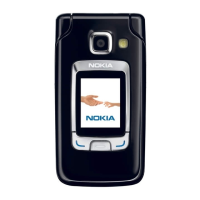Copyright © 2007 Nokia. All rights reserved.
Connectivity
84
Do not point the infrared (IR) beam at anyone's eye or
allow it to interfere with other IR devices. This device is a
Class 1 laser product.
Send and receive data
1. Ensure that the infrared ports of the devices face each
other. The positioning of the devices is more important
than angle or distance.
2. To turn on infrared on your device, select Menu >
Settings > Connectivity > Infrared. Turn on infrared
on the other device. Wait a few seconds until an
infrared connection is established.
3. To send, locate the desired file in an application or the
file manager, and select Options > Send > Via
infrared.
If data transfer is not started soon after the activation of
the infrared port, the connection is cancelled and must be
started again.
You may not be able to receive data using infrared when
the loudspeakers are in use.
All items received through infrared are placed in the Inbox
folder in Messaging.
Remote synchronization
Select Menu > Settings > Connectivity > Sync.
Sync enables you to synchronize your calendar, contacts,
or notes with various calendar and address book
applications on a compatible computer or on the internet.
The synchronization application uses SyncML technology
for synchronization.
Create a new synchronization profile
1 If no profiles have been defined, the phone asks you if
you want to create a new profile. Select Yes.
To create a new profile in addition to existing ones,
select Options > New sync profile. Choose whether
you want to use the default setting values or copy the
values from an existing profile to be used as the basis
for the new profile.
2 Define the Applications to be synchronized.
Select an application, and edit the synchronization
settings:
Include in sync — to enable or disable the
synchronization
Remote database — the name of the used remote
database
Synchronisation type — Select Both ways for
synchronization of the data on your phone and the
remote database, To phone only for the

